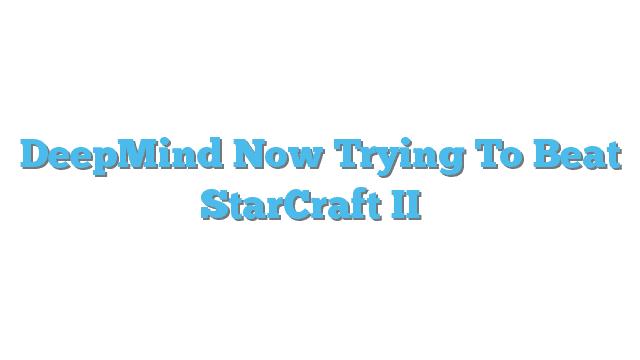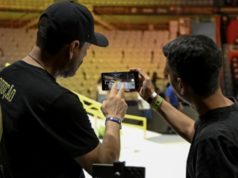The London-based AI research firm, a subsidiary of Google, is teaming up with Californian gaming company Blizzard to take on the real-time strategy game StarCraft II.
One of the most popular eSports in the world, StarCraft II meets many of the requirements for an interesting challenge for DeepMind to take on. Not only do the game’s best players easily beat the top AI opponents, but it also introduces new domains for the DeepMind team to explore.
Most importantly, StarCraft II is a game full of hidden information. Each player begins on opposite sides of a map, where they are tasked with building a base, training soldiers, and taking out their opponent. But they can only see the area directly around units, since the rest of the map is hidden in a “fog of war”.
“Players must send units to scout unseen areas in order to gain information about their opponent, and then remember that information over a long period of time,” DeepMind says in a blogpost. “This makes for an even more complex challenge as the environment becomes partially observable – an interesting contrast to perfect information games such as Chess or Go. And this is a real-time strategy game – both players are playing simultaneously, so every decision needs to be computed quickly and efficiently.
“An agent that can play StarCraft will need to demonstrate effective use of memory, an ability to plan over a long time, and the capacity to adapt plans based on new information.”
The AI does have some innate advantages, however. One stat that top StarCraft players are ranked on is “actions per minute” (APM): essentially, the amount of times they click each minute. Lacking fingers, muscles, or the possibility of tendonitis, an AI can naturally outclick a human player, which could result in it winning not through strategic thinking but simply by reacting quicker. As a result, DeepMind will be capping the AI at what research scientist Oriol Vinyals describes as “high-level human” speed. That also helps ensure the AI doesn’t waste processing power making thousands of minor decisions a minute, and focuses it on the key points.
Vinyals has long experience with StarCraft. In 2010, while an undergrad at UC Berkeley, he built an AI agent which could play the first game in the series better than any of the built-in AIs. But that bot was a simple scripted system, with each rule it followed lain down by hand, similar to how the best AIs played Go before DeepMind came along. In StarCraft II, as in Go, DeepMind wants to focus on machine learning, designing an AI that can teach itself to play the game.
This time, the company’s getting a helping hand from Blizzard, the developer behind StarCraft (as well as World of Warcraft, Hearthstone, and Overwatch), and that help will filter down to any other AI researcher who wants to take on the same challenge. In the first quarter of 2017, Blizzard will be updating StarCraft II to introduce a new AI research environment to the game, offering an API that developers can use to pull out extra information from the game to teach their bots how to play.
The end goal for DeepMind is still to build a computer that can play StarCraft the way a person can, by simply looking at the pixels on the screen and sending keyboard and mouse input to manipulate them. But in the short term, it’s a lot easier for DeepMind to teach their system with a simplified view, that spits out low resolution images of the map and mini map, and breaks down the features into different layers, clearly showing detail such as terrain height, unit type, and health.
The collaboration is a two-way street, with Blizzard hoping to use the findings to improve its own games. “Is there a world where an AI can be more sophisticated, and maybe even tailored to the player?” Blizzard’s Chris Sigaty, executive producer of StarCraft II, said. “Can we do coaching for an individual, based on how we teach the AI? There’s a lot of speculation on our side about what this will mean, but we’re sure it will help improve the game.”
But the aim isn’t just to improve video games. Vinyals says that StarCraft II is a natural next step for the studio’s eventual goal to use AI to solve real-world problems. The lack of perfect information, the realistic (for a certain definition of “realistic”) visuals, the requirement to develop memory and even a sort of imagination all are important skills for an AI trying to understand the real world. Games are a better way to understand the real world than the real world, he says. “You can run them fast, there’s a clear score, or winning and losing. There’s also a lot of signals we can get from the game, and it’s refined by somebody else who thought it was an interesting challenge for humans to learn and master.”
When DeepMind turned its attention to Go, it had beaten the best AI players within a year, and the best human player within two. But neither Vinyals nor Sigaty are eager to stake their colours to the mast on how long it will take for AI to master StarCraft II. “From a research standpoint, we might make great advances, but I think it’s way too early to know whether we could beat the best,” says Vinyals.
Sigaty is slightly more confident. “I stand by our pros. They’re amazing to watch.”
© 2016 Guardian Web
syndicated under contract with NewsEdge. -.



![[World Alzheimer’s Day] Samsung Research Advances Early](https://loginby.com/itnews/wp-content/uploads/2025/09/1758375215_World-Alzheimer’s-Day-Samsung-Research-Advances-Early-238x178.jpg)



